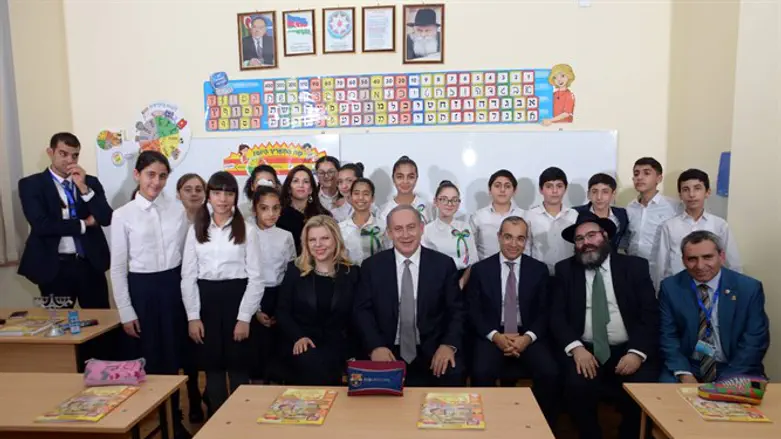
The famous Holocaust scholar Elie Wiesel once stated, “Human suffering anywhere concerns men and women everywhere. We must take sides. Neutrality helps the oppressor, never the victim. Silence encourages the tormentor, never the tormented. Sometimes we must interfere. When human lives are endangered, when human dignity is in jeopardy, national borders and sensitivities become irrelevant. Wherever men and women are persecuted because of their race, religion, or political views, that place must - at that moment - become the center of the universe.”
This year, both Khojaly Genocide Day in Azerbaijan and Purim coincide and are on the same day. As a result, Rabbi Zamir Isayev, the head of the Jewish School in Baku, noted that the Jewish community in Azerbaijan this year will not be celebrating Purim in a joyful manner, out of respect for the innocent people who were slaughtered in Khojaly and Azerbaijan’s great losses during the Second Karabakh War, which happened not long ago. He declared that they will be reading the megillah and doing the Purim-related mitzvahs as prescribed by Jewish Law.
Although Jewish people generally view Purim as the day when Queen Esther saved her nation from facing genocide in Ancient Persia, the holiday has a universal message. It speaks out against annihilating any people for being different and having a separate set of laws. It highlights how one woman, Queen Esther, using her charm, can prevail and avert the destruction of her people orchestrated by a mighty vizier, Haman the Agagite.
Purim also demonstrates the importance of taking a stance against genocide, even if it means risking your own life by doing so.
As Mordechai told Esther when she hesitated about presenting herself before the king without being summoned, as she knew that it could be a death sentence: “Do not imagine that you will be able to escape in the King’s palace any more than the rest of the Jews. For if you persist in keeping silent at a time like this, relief and deliverance for the Jews will come from some other place, while you and your father’s house will perish. And who knows whether it was just for such a time that you attained the royal position.”
There are some revealing parallels between the Purim story and the Khojaly genocide. Just as Haman set out to murder all the Jews under King Achashverosh control in one day, the Armenian government decided to wipe out an entire city in one day for its inhabitants were Azerbaijani and they wanted to set an example.
As former Armenian President Serzh Sargsyan told a British journalist: “Before Khojaly, the Azerbaijanis thought that they were joking with us, they thought that the Armenians were people who could not raise their hand against the civilian population. We needed to put a stop to all that. And that’s what happened.”
Indeed, the Armenian forces planned and orchestrated their assault on Khojaly in a manner that would ensure no survivors. The humanitarian corridor that they created was in fact a death trap and prisoners were given nothing but snow to eat during their time in captivity. As a result, 613 innocent men, women and children were massacred. An additional 1,275 people were taken hostage. Many of those who were held hostage were raped and tortured in the cruelest manner.
This fits the criteria for genocide under international law, as the UN Convention on the Prevention and Punishment of the Crime of Genocide defines any of the following acts committed with the intent to destroy, in whole or in part, a national, ethnic, racial or religious group: a) killing members of that group; b) causing serious bodily or mental harm to the members of that group; c) deliberating inflicting on that group conditions of life inflicted to bring about its physical destruction in whole or in part; d) imposing measures intended to prevent births within the group; and e) forcefully transferring children of the group to another group.
However, while there are parallels to the Purim story, there are also some key differences. Haman the Agagite had bigger aspirations than merely annihilating a city. He wanted all the Jewish people to be slaughtered from India to Persia to Ethiopia, merely because one Jewish man refused to bow down to him. Nevertheless, the most important aspect of the Purim story is that he failed to achieve his goal. Instead of slaughtering the Jews, Haman and his sons were hanged on the gallows after Queen Esther intervened and cleverly managed to save her people.
In contrast, there was no Azerbaijani Queen Esther to save the people of Khojaly. Nevertheless, the message that one must always fight against genocide is universal. For this reason, Khojaly Genocide Day and Purim coexist together in Azerbaijan in harmony, even though Khojaly Genocide Day is a day of mourning and Purim is a day of joy. Khojaly Genocide Day shows us what happens when there is no Queen Esther to save her people from annihilation and why we must always fight against genocides and other crimes against humanity.
Rachel Avraham is a political analyst working at the Safadi Center for International Diplomacy, Research, Public Relations and Human Rights. She is the author of “Women and Jihad: Debating Palestinian Female Suicide Bombings in the American, Israeli and Arab Media.”